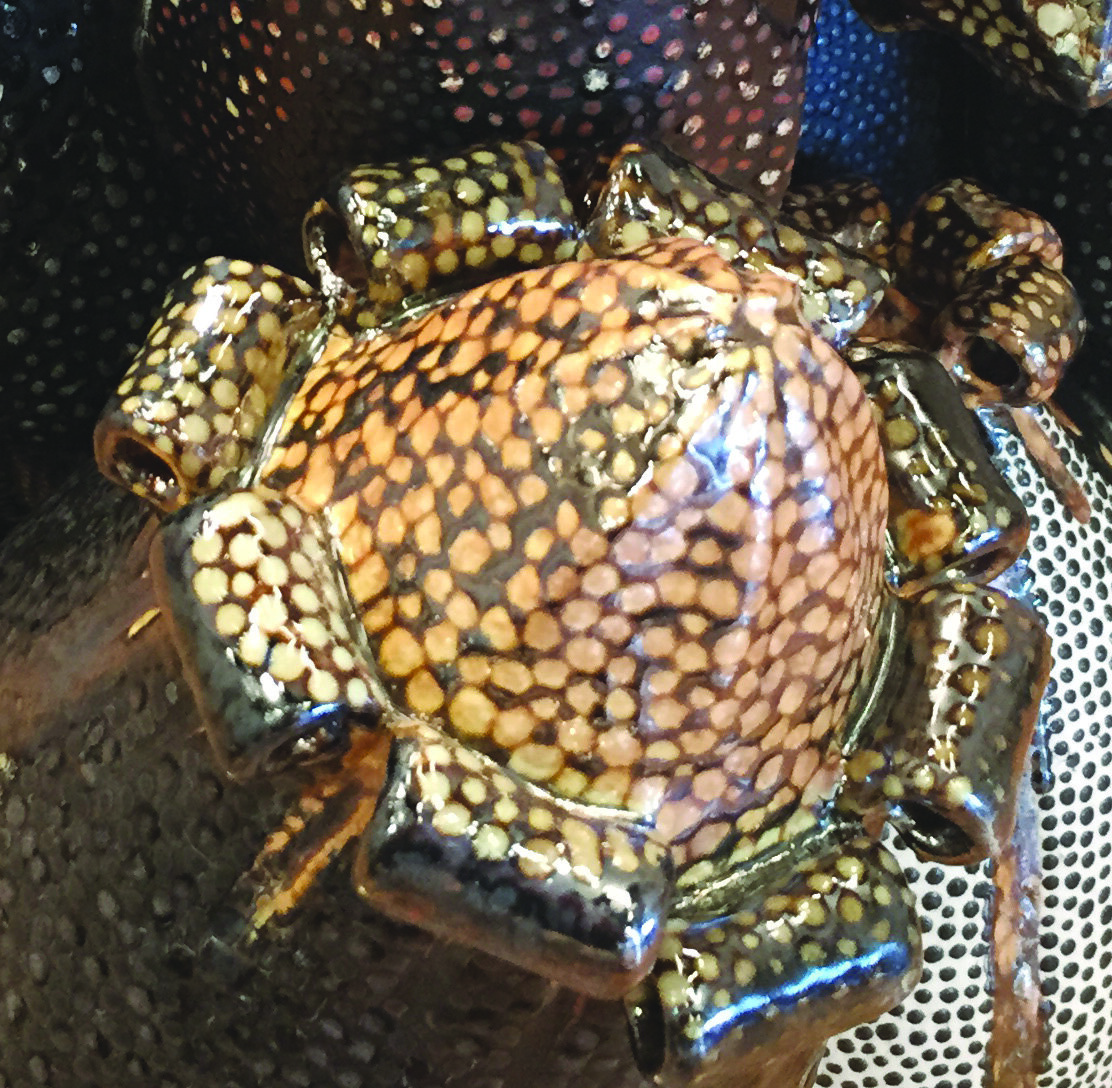
2013-2016 [selected]
To progress my methodology in creating ceramics through the synthesis of coil building, the clay modelling method that I began practicing in Japan, and the method of decorating ceramics at Bien Hoa, a ceramics producing area in the South of Vietnam. In the rigid world of ceramics that requires also scientific knowledge (e.g. the firing or the chemical reaction between clay and glaze) besides dexterity and creativity, coil building brings total freedom in the modelling process. By adapting the coil building method, it is possible to translate an imagination into a real clay sculpture at one time (without the repetition of any step within the modelling process). In a traditional glazing method of Bien Hoa ceramics in Southern Vietnam, a carved line is used to prevent different glazes from overlapping with each other. On my rough and complex-surfaced sculptures, I took the initiative to scale intended glazed surface down to glazed dots; thus, the carved contour of each glazing area becomes unnecessary. Historically, pointillism was developed in the nineteenth century by Georges Seurat and Paul Signac, branching from Impressionism. Technically, this advanced scale of surface down to dots adapted the shrinkage effect which is a flaw of inadequate bond between ware surface and coated glaze. Crawling was named for the condition that molten glaze withdraws into ‘islands’ leaving bare clay patches; in severe cases the glaze forms beads. Viewing these ceramic sculptures from a distance, only colored forms might be seen. The closer we come, the more obviously the color glazed dots appear. This optical illusion helps to create the feeling that the artwork is animated.
![2013-2016 [selected]](https://images.squarespace-cdn.com/content/v1/5af1678b3e2d0974feaaf5e1/1565144199657-76IU8H7Q6ETVYW1TKMSC/ltnph_2015ReflectionSolo.jpg)
2013-2016 [selected]
Was It As It Was Seen
2015 | Ceramics
Installation at solo exhibition <Reflection> | 2015. 12 | Art Space Niji, Kyoto, Japan | photo Takeru Koroda
![2013-2016 [selected]](https://images.squarespace-cdn.com/content/v1/5af1678b3e2d0974feaaf5e1/1565144227962-2A8Q4PFOBGT64OXCVV5G/ltnph_2015thetempter%27stail.JPG)
2013-2016 [selected]
The Tempter’s Tail
2015 | Ceramics | L60 x W24 x H23 cm
![2013-2016 [selected]](https://images.squarespace-cdn.com/content/v1/5af1678b3e2d0974feaaf5e1/1565144368935-KWU38636PR9ZXWJ1IJBH/ltnph_2015.JPG)
2013-2016 [selected]
Wormwood Grows Straight With Hemp
2015 | Ceramics | L43 x W39 x H84 cm
![2013-2016 [selected]](https://images.squarespace-cdn.com/content/v1/5af1678b3e2d0974feaaf5e1/1565144338974-7OA2ZKLXS7DTYMNX0FIG/ltnph_2015ScentlessBeauty.jpg)
2013-2016 [selected]
Scentless Beauty
2015 | Ceramics | L38 x W36 x H40 cm
![2013-2016 [selected]](https://images.squarespace-cdn.com/content/v1/5af1678b3e2d0974feaaf5e1/1565144950526-0FMVZ0TGR78O4NI2XK3J/ltnph_2013orchid.JPG)
2013-2016 [selected]
Orchid
2013 | Semi-porcelain | L23 x W14 x H15 cm
![2013-2016 [selected]](https://images.squarespace-cdn.com/content/v1/5af1678b3e2d0974feaaf5e1/1565144476419-D2E9X3871SLOIFL0V7YY/ltnph_2014TranquillityofLotus.jpg)
2013-2016 [selected]
Tranquillity Of Lotus
2014 | Ceramics
Installation at the sponsored solo exhibition <Wormwood Grows Straight With Hemp> | 2015. 05 | Art Space Niji, Kyoto, Japan
![2013-2016 [selected]](https://images.squarespace-cdn.com/content/v1/5af1678b3e2d0974feaaf5e1/1565144438737-M2PZQ15HSJQHRHNBST7E/ltnph_2014Poppy.jpg)
2013-2016 [selected]
Poppy
2014 | Ceramics | L30 x W30 x H45 cm
![2013-2016 [selected]](https://images.squarespace-cdn.com/content/v1/5af1678b3e2d0974feaaf5e1/1565144399565-KQ55XUXNMO32LKNX42UF/ltnph_2014Poppybowl.JPG)
2013-2016 [selected]
Poppy Bowl
2014 | Ceramics
![2013-2016 [selected]](https://images.squarespace-cdn.com/content/v1/5af1678b3e2d0974feaaf5e1/1565144927289-K71QV9HG938P95K43UH5/ltnph_2013oxblood.JPG)
2013-2016 [selected]
Ox Blood Stone
2013 | Semi-porcelain | L16 x W13 x H10 cm
![2013-2016 [selected]](https://images.squarespace-cdn.com/content/v1/5af1678b3e2d0974feaaf5e1/1565144217066-3DFENOUYHKNJN9XDVK6Z/ltnph_2015Competitive.jpg)
2013-2016 [selected]
Competitive
2015 | Ceramics | L31 x W28 x H49 cm
![2013-2016 [selected]](https://images.squarespace-cdn.com/content/v1/5af1678b3e2d0974feaaf5e1/1565144352358-TIGKHWMX398ZT25V3CVJ/ltnph_2015knot.JPG)
2013-2016 [selected]
Knot
2015 | Ceramics | L51 x W36 x H33 cm
![2013-2016 [selected]](https://images.squarespace-cdn.com/content/v1/5af1678b3e2d0974feaaf5e1/1565144494022-4E29HC7B778AHK6DOX6Y/ltnph_2014WhenAPigeonCameUponARoastedChicken.jpg)
2013-2016 [selected]
When A Pigeon Came Upon A Roasted Chicken
2014 | Ceramics
Installation at the sponsored solo exhibition <Wormwood Grows Straight With Hemp> | 2015. 05 | Art Space Niji, Kyoto, Japan
![2013-2016 [selected]](https://images.squarespace-cdn.com/content/v1/5af1678b3e2d0974feaaf5e1/1565145011898-N3B0JCE5LMTJTZECCZ0L/ltnph_2013PlaceOfLiving1.JPG)
2013-2016 [selected]
Place Of Living
2013 | Ceramics, natural plants
Installation at the exhibition <Ceramics of Contemporary Students in Kyoto> | 2013. 09 | The Former Rissei Elementary School, Kyoto, Japan
![2013-2016 [selected]](https://images.squarespace-cdn.com/content/v1/5af1678b3e2d0974feaaf5e1/1565144954016-6MWCQ1T7W68TFA11ULDH/ltnph_2013pizza.JPG)
2013-2016 [selected]
Pizza
2013 | Mixed-media | L45 x W35 x H13 cm
![2013-2016 [selected]](https://images.squarespace-cdn.com/content/v1/5af1678b3e2d0974feaaf5e1/1565144199657-76IU8H7Q6ETVYW1TKMSC/ltnph_2015ReflectionSolo.jpg)
![2013-2016 [selected]](https://images.squarespace-cdn.com/content/v1/5af1678b3e2d0974feaaf5e1/1565144344280-VFDI3918OYAW1R63H0QQ/ltnph_2015Subtle.jpg)
![2013-2016 [selected]](https://images.squarespace-cdn.com/content/v1/5af1678b3e2d0974feaaf5e1/1565144227962-2A8Q4PFOBGT64OXCVV5G/ltnph_2015thetempter%27stail.JPG)
![2013-2016 [selected]](https://images.squarespace-cdn.com/content/v1/5af1678b3e2d0974feaaf5e1/1565144368935-KWU38636PR9ZXWJ1IJBH/ltnph_2015.JPG)
![2013-2016 [selected]](https://images.squarespace-cdn.com/content/v1/5af1678b3e2d0974feaaf5e1/1565144338974-7OA2ZKLXS7DTYMNX0FIG/ltnph_2015ScentlessBeauty.jpg)
![2013-2016 [selected]](https://images.squarespace-cdn.com/content/v1/5af1678b3e2d0974feaaf5e1/1565144950526-0FMVZ0TGR78O4NI2XK3J/ltnph_2013orchid.JPG)
![2013-2016 [selected]](https://images.squarespace-cdn.com/content/v1/5af1678b3e2d0974feaaf5e1/1565144476419-D2E9X3871SLOIFL0V7YY/ltnph_2014TranquillityofLotus.jpg)
![2013-2016 [selected]](https://images.squarespace-cdn.com/content/v1/5af1678b3e2d0974feaaf5e1/1565144438737-M2PZQ15HSJQHRHNBST7E/ltnph_2014Poppy.jpg)
![2013-2016 [selected]](https://images.squarespace-cdn.com/content/v1/5af1678b3e2d0974feaaf5e1/1565144399565-KQ55XUXNMO32LKNX42UF/ltnph_2014Poppybowl.JPG)
![2013-2016 [selected]](https://images.squarespace-cdn.com/content/v1/5af1678b3e2d0974feaaf5e1/1565144927289-K71QV9HG938P95K43UH5/ltnph_2013oxblood.JPG)
![2013-2016 [selected]](https://images.squarespace-cdn.com/content/v1/5af1678b3e2d0974feaaf5e1/1565144217066-3DFENOUYHKNJN9XDVK6Z/ltnph_2015Competitive.jpg)
![2013-2016 [selected]](https://images.squarespace-cdn.com/content/v1/5af1678b3e2d0974feaaf5e1/1565144352358-TIGKHWMX398ZT25V3CVJ/ltnph_2015knot.JPG)
![2013-2016 [selected]](https://images.squarespace-cdn.com/content/v1/5af1678b3e2d0974feaaf5e1/1565144494022-4E29HC7B778AHK6DOX6Y/ltnph_2014WhenAPigeonCameUponARoastedChicken.jpg)
![2013-2016 [selected]](https://images.squarespace-cdn.com/content/v1/5af1678b3e2d0974feaaf5e1/1565145011898-N3B0JCE5LMTJTZECCZ0L/ltnph_2013PlaceOfLiving1.JPG)
![2013-2016 [selected]](https://images.squarespace-cdn.com/content/v1/5af1678b3e2d0974feaaf5e1/1565144954016-6MWCQ1T7W68TFA11ULDH/ltnph_2013pizza.JPG)